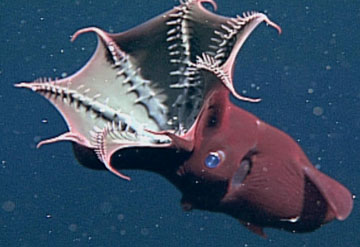Evidently hell is in the oxygen minimum zone. We started class with a recap of the previous day's lab. There was then an introduction of today's lab. We were taught about how to use an oscilloscope. We next watched a movie about an astrophysicist from Penn. In it, he attached a device to a balloon. The device captured various data about the universe. It had to be in a balloon to get it above most of the atmosphere, because the atmosphere was water in it. Water can absorb microwaves, one of the things the device collects data on. The balloon was launched in Antartica, because there are very regular, circular wind patterns there. Upon landing, the parachute did not detach, and it blew across the frozen landscape. The hard drive came detached, and so they had to find it. It was an interesting movie.
We next had a biophysicist as a guest speaker. Alison Sweeney did almost all of her work in marine biology. We learned about the giant clam. It depends on algae to produce nutrients. It has a very high concentration of algae compared to other animals. This is because it has something in its shell that refracts light into the colors that the algae is best able to use. We also learned about a kind of squid that lives deep in the ocean. It has evolved to avoid being noticed. The first attribute is that it is mostly transparent. This means that you could not see the transparent bits against the dark background, so it is harder to spot. Some body parts cannot be made transparent: the gut and the eyes. The gut has evolved to be very thin, like a needle. Muscles keep the gut pointed upwards, so it makes the least possible shadow. The eyes are much more interesting. It directs a bioluminescence through something similar to a fiber-optic cable. This light precisely cancels out the light reflected from the eyes. We then learned a bit about
Vampyroteuthis infernalis, the vampire squid of hell. It is interesting for its looks, its name, and its ability to survive in the oxygen minimum zone. In the oxygen minimum zone, there is almost no oxygen (as little as 3%). To survive, the vampire squid has an incredibly low metabolism. It is able to use almost no oxygen. I also learned about how cuttlefish can see the polarity of light.
 |
| The oscilloscope |
I then had lunch. After lunch, we were told a bit about our trip to Hersheypark on Friday. We will be strapping accelerometers to ourselves, then riding roller coasters. Afterwards, we will analyze the data. The final thing we did in class today was a lab measuring the speed of sound and the speed of electricity with an oscilloscope. One of the main goals was to get comfortable with the oscilloscope. TO measure the speed of sound, we had microphones to convert sound to voltage. The oscilloscope measured voltage. We placed two speakers a known distance apart, then made a sharp sound. We could then see the distance between disturbances on the oscilloscope, and from there look at the change in time. To measure the speed of electricity, we did a similar thing. We had a pulse be sent out. In one direction, it went directly to the oscilloscope. In the other direction, it went around a wire to an oscilloscope.
After class, I programmed in my room. I was working on multithreading a game I am working on. I am having it generate the path from Point A to Point B in a separate thread, which means that the computer is able to do this at the same time as it does other things in the game. I had done most of the work last night. The tricky part is that which thread the path algorithm is evaluated in has to be switched mid-function for it to interact with the obstacles it is pathing around correctly. I eventually got the thing to work, but unfortunately every time it switches threads, it has to wait a frame. This means that, after receiving an order, the things that are supposed to path sit there for a while before moving. I decided to take a break from programming by programming some more. The side project was working on good searching algorithms. I then had dinner, then programmed some more.



No comments:
Post a Comment